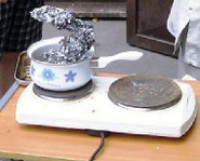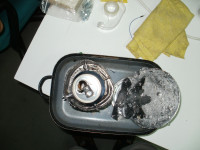Table of Contents
Metal casting
| Metal casting | |
|---|---|
 |
|
| founder: | Stevko |
| depends on: | |
| interested: | |
| software license: | - |
| hardware license: | - |
~~META: status = active &relation firstimage = :project:metal.jpeg ~~
We want to try working with lead and other metals and cast various object from them. We started with lead, because it melts at low temperature and because most home-casting is done with lead.
Why?
- Because working with liquid metals is cool (isn't that why people do soldering?).
- Because sometimes you want something to be made from lead.
- Because it is like old school/steampunk reprap.
Equipment
Available:
- Pot for lead.
- Spoons to fiddle with it.
- Electric cooker to melt it.
- Plaster (bad one)
Would be nice to have:
- Metal bucket for those who want to pour lead to water and do fortunetelling from its shape.
- Plaster (better one)
- Another pot(s) (with lid and not enamel)
- More lead
- Other metals
Equipment needed
- Thermal insulation (middle layer) - http://www.ekomirelon.cz/Sortiment/Sibral
- Steel tubes (outer and inner layer) -
- gas-powered
- Propane-butane flask
- …
- electrically powered
- canthal wires
- …
- šamotové alebo keramické (sibral) tvarovky
- graphite or ceramic crucible for liquid metal
- various heat-proof tools
- aluminium alloy, silver, bronze, ..
- mold frames and filler
- gypsum, fire clay (chamotte), sand, wax
- dirt space
Where to get lead?
The easiest way to get lead is at scrapyards. http://www.vykupkovu.eu/ in Prague 5 sells lead for 30CZK/kg but at the time of writing (2012-07-29) has no lead (we bought all three kilograms). http://www.inkovpraha.cz/ sells lead for 40CZK/kg. There are more scrapyards around Prague, but these are in walking distance from metro stations (Smíchovské nádraží and Radlická respectively).
We could buy lead from other (nonscrapyard) places (where?).
We could dismantle old car batteries (we should find out, what to do with acid).
Safety
As we know, lead is poisonous and molten lead is hot. So be careful. It is recommended to work with molten lead outside.
We have:
- Leather gloves
- Safety gogles
- Face shield (in case of splashes - when working outside, beware of rain)
- Some lab coat
- Several respirators
What we should consider getting:
- Another lab coat
Status
We took lead from scrapyard and melted it (electric cooker works fine). Then poured it into water (we hoped that dirt would not stay mixed with lead - did not work). Then we melted it again and used spoons to get the dirt away. We created very simple mold from plaster - plaster is now drying, so nothing else was done.
- We found out, that plastic bucket full of water can withstand three kilograms of molten lead being poured in it.
- We found out that after pouring lead to water, it gets spikes (that can hurt a little).
- We found out, that enamel pot is not the best type of pot for this kind of things (enamel falls off).
- We found out that we probably do not want to buy plaster in Tesco.
2012-08-07 Tuesday
We took our plaster mold and tried to cast first small very thin brick of lead. Since the mold was very shallow, the resulting piece of lead is very thin and even has holes. Part of lead leaked on ground. We found out that plates from ground are quite nice, so maybe later instead of mold we will put barriers on ground and pour lead into them.
We tried another plaster mold. It was drying very slowly and while putting it into oven helped, it was not as dry as it should have been when lead was poured in it. The resulting brick has bubble from bottom side.
We tried to cool lead by putting the pot (bottom first) to water. The lead from pot could be then taken out and now we have pretty circular plate of lead.
Another thing we found put is that lead from scrapheap can have bad things on it. Things that smell really bad (probably some glue and rubber). One possibility is to let it burn in pot. It must be done outside and door and windows to building must be closed. Respirator is recommended. We should get one.
2012-08-11 Saturday
A new pot and a pan was bought.
We tried working with respirator on and decidet it is not worth it (and it does not seem to work as expected, but this might be a user problem).
All remaining lead pipes were melted except the part that smelled very badly last time (we threw it away). We used spoon to get rid of all dirt.
We poured lead to pan and got a big rectangular piece of lead that was, however, too thick to use. Then we poured about one centimeter thick layer to a new pot and then used chisel to make a square of it. That worked quite well, but we decided that while we could create more such squares and then connect them, we could use a simpler idea.
We took some lead and poured it into pot to make a bottom layer. Then we placed an empty can on it and poured lead around can. We found out that it is quite hard to keep a can upright and inside molten lead since lead has very high density and empty can has very low. Also the pot is quite wide so the resulting box has very thick walls and quite thick bottom, it is quite shallow. We used square piece as a cover.
2012-08-13 Monday and 2012-08-14 Tuesday
The new box was created. A small can was placed inside a larger can and held a few centimeters above the bottom using two long nails. The lead was poured between cans and left to cool in air. We got a new box as a result.
However there were places in the wall of the box where bubbles in lead bursted. We poured the lead to fill these bubbles using spoon. Also the top side of the box is not smooth so lid does not fit. The lid for the box was created by pouring the lead on lid of the large can.
Next time we will try to repeat process but heat the lead when between cans and cool it more slowly so that we get smooth surface and eliminate bubbles.
Ideas
- We could make tin soldiers or something (from tin obviously).
- We might try to get or build furnace to melt other metals (aluminium, duralumin) to create object from less toxic materials.
- Tlapka had the idea to try making bronze. Bronze age style.
- Cast into gypsum form made around repraped prototype: http://3dtopo.com/lostPLA/
Cast aluminium using hairdryer? :) 1I3P6pmy3P0
Or microwave? GwQ4C2dNkp4 http://www.instructables.com/id/microwave-smelter/

